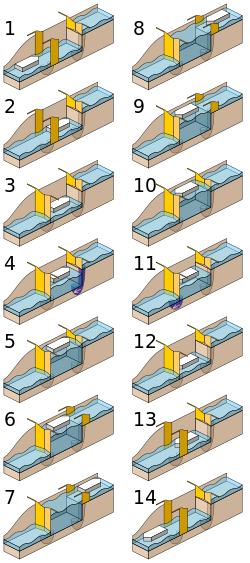Lock (water navigation)
A lock is a part of a navigable waterway system that makes a water "channel" deep enough for vessels to use. The lock controls pool depths, for example in a lock and dam system across a waterway.
The lock is a place where boats that travel up or down a river or canal can be moved to the next higher or lower level. Locks are built in places where the level of the water in the river or canal suddenly changes. This may be because of a waterfall there, or because a dam or a weir has been built, or because some other thing is in the way. The lock is like a big chamber with gates at each end. They have lock gears which empty or fill the chamber with water. Locks help a river to be more easily navigable (easier for boats to travel up and down), or for canals to be built across country that is not level.
A pound lock, the most common sort, has a chamber with gates at both ends that control the level of water.[1] They were first used in China during the Song Dynasty (960–1279 AD). On rivers locks were built from turf. Most of them have been rebuilt in brick or stone.[2]

All pound locks have three elements:
- A watertight chamber connecting the upper and lower canals, and large enough for one or more boats. The position of the chamber is fixed, but its water level can vary.
- A gate (often a pair of "pointing" half-gates) at each end of the chamber. A gate is opened to allow a boat to enter or leave the chamber; when closed, the gate is watertight.
- A valve (traditionally, a flat panel (paddle) lifted by winding a rack and pinion mechanism) which allows water to drain into or out of the chamber. Larger locks may use pumps.
Canal lock and lock-keeper's cottage on the Aylesbury Arm of the Grand Union Canal at Marsworth in Hertfordshire, England.
Lock on the River Neckar at Heidelberg in Germany.
Three Gorges Dam lock near Yichang on Yangtze river, China.
A plan and side view of a generic, empty canal lock. A lock chamber separated from the rest of the canal by an upper pair and a lower pair of mitre gates. The gates in each pair close against each other at an 18° angle to approximate an arch against the water pressure on the "upstream" side of the gates when the water level on the "downstream" side is lower.
Sequence of operation of a canal pound lock:*1. Boat sailing upstream*2. Boat enters lock*3. Downstream gates close*4 and 5. Chamber filled*6. Upstream gates open*7. Boat leaves lock*8. Boat sailing downstream*9. Boat enters lock*10. Upstream gates close*11 and 12. Chamber emptied*13. Downstream gates open 14. Boat leaves lock
A series of photos of the Canadian Locks in Sault Ste. Marie to illustrate a drop of about 22 ft (6.7 m) in a lock
References
- ↑ "7 of the World's Most Impressive Locks". Popular Mechanics. 2016-12-13. Retrieved 2023-04-01.
- ↑ "Monkey Marsh Lock". Waterscape. 2012. Archived from the original on 3 April 2012. Retrieved 1 April 2023.
{{cite web}}: CS1 maint: bot: original URL status unknown (link)









